Science Reporter Summary March 2024
Science Reporter Magazine Summary March 2024
In this Science Reporter summary March 2024 edition, we will discuss topics such as the first sighting of the Varanus flavescens lizard in Uttarakhand and new ways to help wildlife in India. You’ll learn about how climate change affects forests, the growth of plants in different areas, and how diseases spread across countries. Each article offers insights into important research and effort to protect our environment.
ARTICLE 1: Record of the Varanus Flavescens from Uttarakhand
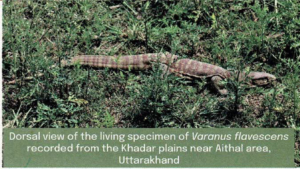
- Verses flavescens, the largest Saurian in the world is a threatened and elusive monitor lizard endemic to South and Southeast Asia, including India. Despite being reported from various regions such as the Indus, Ganges, and Brahmaputra rivers, authenticated information on its distribution in Uttarakhand State was previously unavailable.
Varanus flavescens Discovery in Uttarakhand:
- A recent study published in the National Academy Science Letters documents the first recorded instance of Varanus flavescens in Uttarakhand, North India, supported by photographic evidence.
- The specimen was found near Bukkanpur village in the Haridwar district, adjacent to the Pathri forest reserve and the Banganga river, within an area predominantly occupied by agricultural fields.
Historical Context and Threats:
- First described by Hardwicke and Gray in 1827, Verses flavescens faces threats across its range due to habitat destruction and illegal poaching, driven by demands for its skin, meat, and alleged medicinal properties.
- This illegal trade poses a significant risk to the species’ survival, particularly in South Asia.
Conservation Recommendations:
- The discovery underscores the need for baseline studies to assess the region’s herpeto-fauna diversity and effectively monitor Verses flavescens‘ habitat.
- Community participation in conservation efforts is crucial, and initiating conservation initiatives, particularly in areas where the species is newly discovered, is imperative for its long-term survival.
- Strengthening data on geographical distribution and status is vital for effective conservation planning and management.
Conclusion
- The documentation of Verses flavescens in Uttarakhand fills a significant knowledge gap and highlights the urgent need for conservation action to protect this threatened species and its habitat in northern India.
ARTICLE 2: Climate Change will Affect Fire Weather Danger in Indian Forests
- Human activity is undeniably driving unprecedented changes in Earth’s climate, with rising atmospheric temperatures being a significant consequence.
- These changes are expected to persist and intensify, posing various challenges, including increased fire weather danger in many Indian forests.
Study by IIT Delhi: Projections and Findings
- A recent study conducted by researchers at the Indian Institute of Technology (IIT) Delhi focused on the impact of climate change on forest fire risks in India.
- Utilising a high-resolution dataset of future climate projections, the researchers calculated the Fire Weather Index (FWI) for forested regions nationwide.
- Their analysis revealed alarming trends, particularly in Central and South India and the Himalayan region, where significant increases in FWI were projected by the end of the century.
- Additionally, the study forecasted a lengthened fire season in these areas, extending by 12-61 days.
Regional Variances in Forest Fire Hazards
- The study’s findings corroborate the widely held belief that rising temperatures exacerbate forest fire hazards.
- However, an intriguing aspect emerged from the research, indicating that this correlation doesn’t hold true for all forest ecosystems.
- While humid tropical forests in the Western Ghats and parts of the Northeast are expected to witness temperature increases, projections also indicate rises in rainfall and humidity.
- Consequently, these areas are anticipated to experience lower FWI despite warming temperatures.
Insights from Experts
- Dr. Somnath Baidya Roy, a Professor and Head of the Centre for Atmospheric Sciences, emphasised the necessity of studying forest fires in India with a granular approach, considering the diverse climate and forest types across the country.
- He highlighted the inadequacy of coarse-resolution global studies for comprehensively addressing India’s forest fire dynamics.
- Anasuya Barik, the study’s lead author and a PhD student at the Centre for Atmospheric Sciences, underscored the groundbreaking nature of their research, emphasising its implications for forest fire management.
- She advocated for developing localised fire danger thresholds and management policies rather than relying solely on national-level strategies.
Publication and Implications
- The study’s findings were published in Communications Earth and Environment, marking a significant contribution to the understanding and managing forest fires in India.
- By highlighting the need for tailored approaches to forest fire prevention and mitigation at local levels, the research underscores the importance of incorporating regional nuances into broader climate adaptation strategies.
ARTICLE 3: Logging and Climate Change Threaten Montane Birds
- Researchers at the Indian Institute of Science (IISC) Bengaluru conducted a comprehensive study investigating the impacts of forest logging and climate change on bird communities in tropical mountains.
- Their research, published in Global Ecology and Conservation, utilised over ten years of data and focused on understanding how bird community compositions changed in primary (undisturbed) forests compared to logged forests in the mid-elevation Eastern Himalayan region.
Unique Ecosystems of Tropical Montane Forests
- Tropical montane forests span from around 150-200 meters to as high as 3,500 meters on mountains worldwide and are crucial centres of biodiversity.
- Each species within these ecosystems occupies a distinct niche, fostering immense diversity in a compact space.
Threats Posed by Forest Loss and Climate Change
- Forest loss and climate change pose significant threats to these ecosystems, particularly given the temperature sensitivity of tropical mountain biodiversity.
- The joint influence of these threats has been underexplored in scientific research.
Findings on Bird Species Shifting and Colonization Patterns
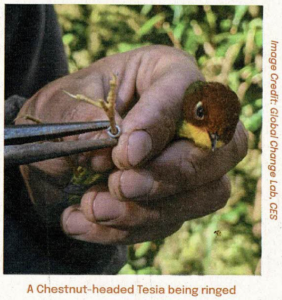
- The research team observed that rising temperatures have prompted many bird species to migrate to higher elevations.
- Logged forests, characterised by higher temperatures and lower humidity compared to primary forests, facilitate this transition.
- Smaller bird species seem to adapt better to these conditions, while larger species show increased density in primary forests.
Study Site and Methodology
- Data were collected from the Eaglenest Wildlife Sanctuary in Arunachal Pradesh, Eastern Himalayas, a biodiversity hotspot housing over 500 bird species.
- Intensive logging until 2002 created notable differences between logged and intact forests, providing ideal conditions for the study.
- Local community support was crucial for conducting fieldwork in such remote areas.

Mist Netting and Analysis
- The team employed mist netting to capture and study understorey insectivores, focusing on their well-defined niches and abundant data availability.
- Out of the 6,189 captured individuals from 130 species, the analysis centred on 4,801 understorey insectivores belonging to about 61 species.
Impact of Logging on Biodiversity and Resource Availability
- Logging led to losing large-bodied, old, growth-dependent bird species and overall biodiversity decline.
- Understorey insectivores, which rely on specific niches, exhibited significant declines in logged forests due to reduced foliage-dwelling insect densities, affecting resource availability.
Implications and Conservation Recommendations
- The study underscores the critical importance of safeguarding primary forests to mitigate climate change effects on biodiversity.
- Preserving undisturbed forests across large elevational gradients is essential for allowing species to shift their ranges upwards in response to climate change, thus ensuring their survival and preventing local extinctions.
- Logging managers are urged to prioritise the protection of primary forests to facilitate species adaptation and conservation efforts.
ARTICLE 4: Carnivorous plant traps help scientists explain the evolution of complex ‘composite’ traits
- An international team of researchers, led by Dr. Ulrike Bauer from the University of Bristol, delved into the characteristics of two tropical pitcher plant species separated by 4000 km of open ocean: the Slender Pitcher Plant (Nepenthes gracilis) from Borneo and Nepenthes pervillei from the Seychelles islands off the East coast of Africa.
Discovery of a Shared Mechanism
- Dr. Bauer and her team made a remarkable discovery: both plant species had independently evolved the exact unusual ‘springboard‘ mechanism to capture insects.
- When raindrops hit the roof-like trap lid of the pitcher plant, insects on the underside of the lid are catapulted into the trap below.
Components of the Springboard Trapping Mechanism
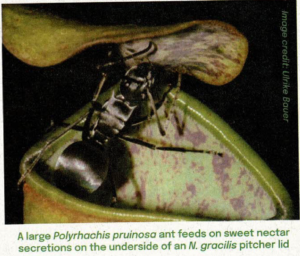
- The effectiveness of the springboard trapping mechanism relies on three key traits.
- Firstly, the lid must be horizontal to ensure the prey lands inside the trap.
- Secondly, the lid acts as a spring, transferring the impact energy of raindrops to the insect.
- Finally, the underside of the lid is coated with fine wax crystals, providing the right level of slipperiness for insects to walk upside down but lose grip when hit by a raindrop.
- All three components are necessary for the trap to function, making it a ‘composite trait’.
Challenges in Explaining Composite Trait Evolution
- Evolutionary biologists face challenges in explaining the emergence of composite traits.
- While natural selection acting on naturally variable traits can account for gradual changes, it struggles to explain entirely novel traits arising from a combination of multiple, previously unrelated components, such as the pitcher plant’s springboard mechanism.
Alternative Hypothesis: Spontaneous Coincidence
- Dr. Bauer and her team proposed an alternative hypothesis for composite trait evolution: spontaneous coincidence or a chance encounter of a new beneficial combination.
- Their research revealed that in most Nepenthes pitcher plant species, the three component traits of the springboard trapping mechanism are unusually variable.
- This variability increases the pool of possible trait combinations, enhancing the likelihood of a beneficial new combination.
- The absence of strong selection facilitates evolution by allowing traits to be more variable, thereby increasing the number of potential evolutionary outcomes.
Conclusion: Implications of the Research
- The study sheds light on the fascinating mechanisms underlying the evolution of composite traits in pitcher plants.
- Challenging traditional explanations of trait evolution opens new avenues for understanding how complex traits emerge in nature.
ARTICLE 5: For most Animals, Sperm Quality does not reduce with Age
- Recent research led by the University of Oxford, published in Nature Communications, challenges the assumption that age universally impacts male fertility across species.
- While human males experience a decline in sperm fitness with age, this study investigates whether such patterns are consistent in other animals.
Research Methodology and Findings
- The study analysed 379 studies encompassing various animal species, including mammals, insects, birds, and fish.
- Surprisingly, advancing age did not consistently affect ejaculate size, sperm quantity, motility, or viability across species.
- Reproductive traits improve with age for some animals, like insects, potentially due to methodological limitations such as keeping males as virgins until old age.
Variability in Age-related Patterns
- Among the animals studied, only lab rodents exhibited age-related deterioration in most ejaculate traits.
- Dr Regina Vega-Trejo, one of the co-lead authors, notes the lack of consistency across species, suggesting that age-related changes in ejaculate traits may not be universal.
Implications for Humans
- The researchers speculate that the stark contrast in ejaculate ageing patterns between animals and humans could be attributed to humans living longer than in previous centuries.
- Consequently, men may live beyond the age at which they evolved to maintain sperm function.
- Co-lead author Krish Sanghvi suggests that stronger animal selection pressures may drive them to maintain sperm function across all ages.
Reproductive Outcomes and Age
- Similar to ejaculate traits, the study found that reproductive outcomes did not improve or decline with advancing age across species, contradicting observations in humans.
- Methodological limitations, such as studying animals rarely at advanced ages for their species and the potential variation in deterioration of male fertility across different ejaculate traits, could partially explain these results.
Conclusion and Implications
- Senior author Dr. Irem Sepil highlights the interdisciplinary relevance of understanding reproductive deterioration, spanning evolutionary ecology, demography, humanities, and medicine.
- The study challenges the notion of universal male reproductive deterioration and provides insights into where and why it may occur across species.
ARTICLE 6: Human activity facilitates invasive plants colonization in Mediterranean ecosystems
- Invasive plants have significantly altered Mediterranean habitats, outcompeting native flora due to their robust spreading mechanisms.
- Professor Sergi Munné-Bosch from the University of Barcelona highlights the efficient dispersal strategies of invasive species like Carpobrotus, Acacia, Agave, and Opuntia, which threaten native biodiversity.
Sophisticated Spreading Mechanisms
- The study underscores the adaptability of invasive plants, particularly Carpobrotus, known for its ability to form hybrids and thrive in Mediterranean environments.
- These plants exhibit a combination of clonal and sexual reproduction, facilitating rapid colonisation of new areas.
- Notably, Carpobrotus species maintain persistent seed banks, ensuring long-term viability and expansion.
Human Activity and Biological Invasions
- Munné-Bosch emphasises human activity as the primary driver of biological invasions.
- Fragmentation of natural habitats through urbanisation, tourism, and other human interventions increases the propagule pressure, enabling invasive species to establish themselves in previously untouched areas.
- The author highlights the Opuntia genus as an example of invasion along coastal regions affected by habitat fragmentation.
Prevention Strategies for Environmental Protection
- Recognising the irreversible changes caused by invasive plants, the author advocates for proactive measures to safeguard natural ecosystems.
- Prevention, rather than eradication, is emphasised as the most effective strategy.
- Munné-Bosch stresses the importance of conservation efforts to preserve natural areas and mitigate the unintentional introduction of invasive species through human activities like landscaping and development.
Conclusion: Prioritising Nature Conservation
- The article underscores the urgent need to prioritise nature conservation to counteract the detrimental effects of invasive plants.
- Protecting natural habitats from further fragmentation and invasion is essential for preserving biodiversity and ensuring the long-term sustainability of Mediterranean ecosystems.
ARTICLE 7: INNOVATION IN ACTION: Harnessing Technology for Wildlife Conservation in India
Preserving India’s Biodiversity
- India boasts a remarkable biodiversity, housing a significant portion of the world’s carnivore species and ranking among the most biodiverse nations globally.
- Despite a population of 1.4 billion, India has successfully preserved its rich biodiversity, with 13% of the planet’s bird species, 7% of mammals, 5% of reptiles, and 4% of amphibians within its borders.
Thriving Endangered Species
- Endangered species like lions, tigers, elephants, and rhinos, which face declining populations elsewhere, thrive and even experience growth in India.
- Traditional conservation methods are now complemented with digital technologies like Artificial Intelligence (AI), Augmented Reality (AR), and Virtual Reality (VR) to protect India’s wildlife heritage.
Revolutionising Wildlife Conservation with Digital Tools
- India utilises digital innovations, including GIS, remote sensing, camera traps, drones, and DNA analysis for wildlife conservation.
- These tools enable precise monitoring, efficient data collection, and better protection strategies against poaching and habitat loss.
- The Indian government leads initiatives like the Integrated Tiger Habitat Conservation Programme and develops digital databases like the Indian Biodiversity Portal to support conservation efforts.
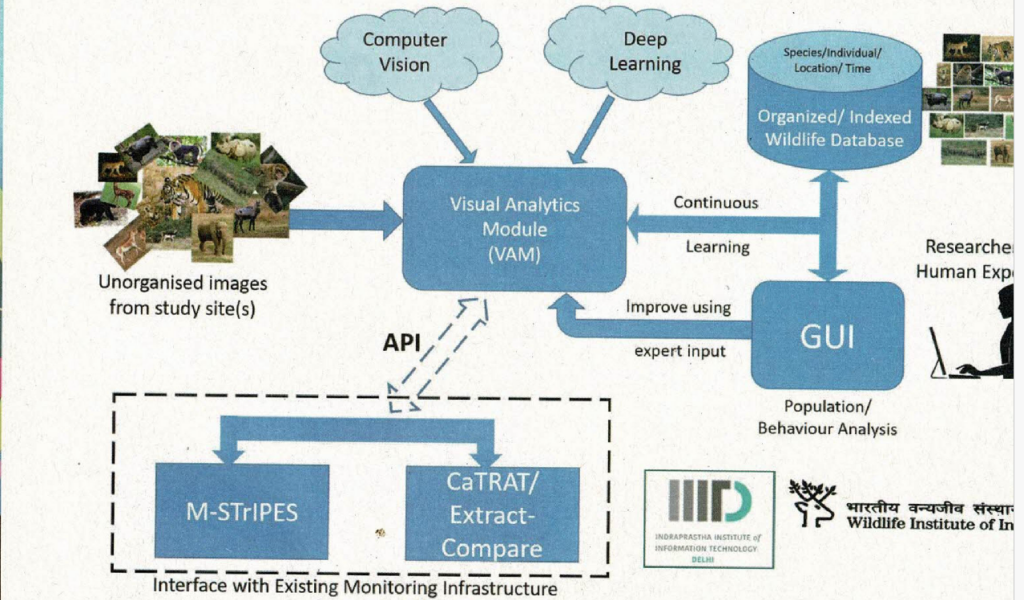 Expert Insights on Climate Change and Digital Innovations
Expert Insights on Climate Change and Digital Innovations
- Experts emphasise climate change’s impact on ecosystems and digital innovations’ effectiveness in combating wildlife crimes.
- Digital technologies are instrumental in monitoring and tracking wildlife, analysing animal behaviour, and engaging citizens in conservation efforts through mobile apps and online platforms.
Conservation Success Stories
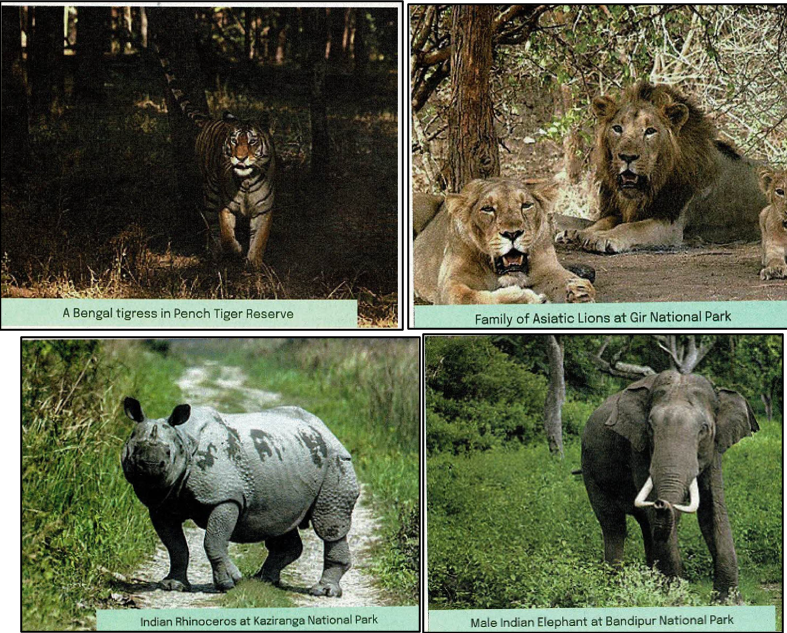
- India has achieved notable success in conserving endangered species such as tigers, rhinoceroses, Asiatic lions, and Indian elephants through protected areas and anti-poaching measures.
- Citizen science initiatives like the Save Our Tiger campaign and local community involvement further contribute to wildlife monitoring and protection.
Future Prospects with AI in Wildlife Conservation
- AI is increasingly employed in wildlife conservation efforts, aiding in satellite imagery analysis, habitat monitoring, species tracking, public engagement, and policy development.
- Tools like camera-trap image segregation and satellite-based monitoring systems enhance conservation efforts and help combat wildlife trafficking.
Augmented Reality (AR) and Virtual Reality (VR) in Conservation
- AR and VR technologies offer immersive experiences to raise public awareness and engagement in wildlife conservation.
- By providing interactive experiences and virtual environments, these technologies educate individuals about the importance of conservation and foster empathy towards wildlife.
Conclusion: Embracing Technological Innovations
- As technology advances, India continues to leverage digital tools and innovative approaches to wildlife conservation.
- The harmonious integration of technology with traditional conservation methods ensures the preservation of India’s abundant wildlife legacy for future generations as we commemorate World Wildlife Day 2024.
ARTICLE 8: URBAN AREA DEVELOPMENT AND WILDLIFE CONSERVATION
Understanding Urbanisation’s Impact on Wildlife

- The projected growth of urban areas due to the increasing human population raises concerns about its impact on wildlife populations and biodiversity.
- Urban development often involves the replacement of natural habitats with dwellings and associated infrastructure, particularly in densely populated urban settlements.
- Despite this, urban areas in developed countries may still contain semi-natural habitats and residential gardens that provide habitats for wildlife species.
Challenges of Urban Wildlife
- Urban wildlife can pose various challenges, including transmitting diseases, damaging structures and vegetation, causing traffic accidents, and creating general nuisance.
- However, the severity of these issues varies, influencing people’s tolerance towards wildlife.
- In India, except for commensal rodents, urban wildlife generally poses few significant problems, and residents highly value nature in their gardens.
International Variations in Urban Areas
- Definitions of urban areas vary internationally, typically based on population density and settlement characteristics.
- Urban wildlife can be categorized into commensal species, synanthropic species, resident species, and vagrant species, depending on their relationship with human habitats.
Urban Fragmentation and Conservation Efforts
- Urban areas in developed countries are often fragmented, containing various habitat types interspersed with residential and industrial zones.
- Urban wildlife conservation aims to create and maintain habitats for native species displaced by human activities, particularly those that avoid urban environments.
- Conservation efforts may include preserving habitat patches and promoting landscape connectivity.
Landscape Ecology and Urban Wildlife
- Landscape ecology considers the interactions between different land cover types and ecosystems within a landscape.
- Urbanisation alters habitat availability and connectivity, affecting wildlife survival and reproduction.
- Habitat fragmentation, degradation, and disruptions in connectivity contribute to the decline of urban avoiders, species that typically avoid urban environments.
Challenges in Urban Conservation
- Urbanisation leads to habitat loss, fragmentation, and changes in habitat quality, affecting wildlife populations’ survival and reproduction.
- Increased densities of non-native predators and competitors, disruptions in nutrient cycles, and habitat degradation further threaten urban wildlife.
- Effective urban wildlife conservation requires coordination at various scales, from local neighbourhoods to entire cities, to effectively address habitat loss and fragmentation.
Integration of Wildlife Conservation with Urban Planning
- Integrating wildlife zoning and green infrastructure into urban planning frameworks can enhance conservation efforts.
- Wildlife zoning organises landscapes based on wildlife use, while green infrastructure focuses on conserving ecological functions within urban areas.
- However, conflicts may arise with other land uses like recreation and transportation, highlighting the need for balanced urban development and conservation approaches.
ARTICLE 9: Disease knows no boundaries, and borders are porous to disease: Transboundary Animal Diseases from an Indian Perspective
Understanding Transboundary Animal Diseases (TADs) in India:
- India’s rich ecosystems and diverse wildlife face a significant challenge in managing Transboundary Animal Diseases (TADs), which are infectious diseases that easily cross international borders.
- These diseases threaten domestic animals, human health, and the environment and result in substantial economic losses.
- Factors such as animal commerce, migration, and travel facilitate the spread of TADs, especially in a country like India, which has diverse climatic conditions and extensive geographical diversity.
Impact on Livestock, Agriculture, and Human Health
- The livestock industry is crucial to India’s economy, as it supports millions of people.
- TADs threaten this industry by causing a decline in livestock productivity, increased mortality, and infertility, affecting producers’ income and food security.
- Additionally, certain TADs can be transmitted to humans, posing risks to public health. Prevention and control measures are essential to safeguard animal and human health and ensure a sustainable agricultural system.
India and Key TADs
- India faces notable challenges from various TADs, including Avian Influenza (Bird Flu), Porcine Reproductive and Respiratory Syndrome (PRRS), Lumpy Skin Disease (LSD), Crimean-Congo Hemorrhagic Fever (CCHF), and African Swine Fever (ASF).
- These diseases can severely affect livestock production, trade, and public health.
- Effective surveillance, vaccination, and biosecurity measures are critical in controlling and preventing their spread.
Avian Influenza (Bird Flu)
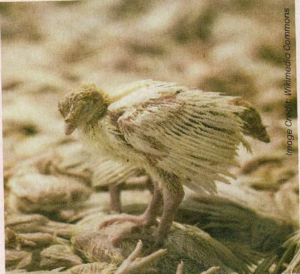
- Avian influenza is highly contagious and primarily affects domestic poultry and wild birds.
- Certain virus strains can infect humans, leading to severe respiratory illnesses.
- India has experienced bird flu outbreaks, resulting in significant economic losses to the poultry industry.
- Vaccination and stringent biosecurity measures are vital in preventing and controlling avian influenza.
Porcine Reproductive and Respiratory Syndrome (PRRS)
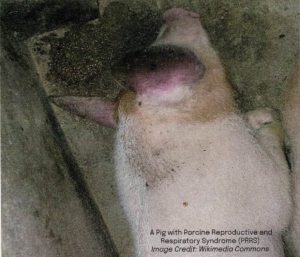
- PRRS is a viral disease that affects pigs and can cause reproductive and respiratory problems.
- India has reported outbreaks of PRRS, leading to economic losses in the pig husbandry industry.
- Control measures include biosecurity protocols, testing, and the use of vaccines.
Lumpy Skin Disease (LSD)
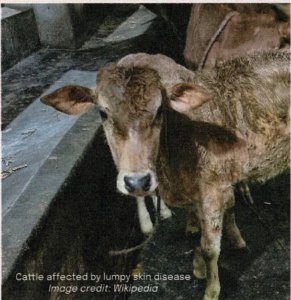
- Lumpy Skin Disease primarily affects cattle and can reduce productivity and trade restrictions during outbreaks.
- India has witnessed the spread of LSD, necessitating vaccination campaigns and vector control measures.
Crimean-Congo Hemorrhagic Fever (CCHF)
- CCHF is a viral illness transmitted by ticks and can affect animals and humans.
- India has reported cases of CCHF, emphasising the importance of surveillance, vector control, and public education to prevent its spread.
African Swine Fever (ASF)
- ASF is highly contagious and affects domestic and wild swine.
- India has experienced outbreaks of ASF, leading to significant economic losses in the pig industry.
- Prevention efforts include biosecurity measures and early detection.
Addressing TADs in India
- The Indian government and relevant authorities have implemented measures to address TADs, including border surveillance, strengthening veterinary services, public awareness campaigns, and regional cooperation.
- Additionally, wildlife protection and conservation efforts are crucial in preventing disease spread.
- Vaccination programs, capacity building for veterinarians, and international collaboration are essential in combating TADs effectively.
Conclusion
- Transboundary Animal Diseases pose complex challenges globally, impacting livestock, agriculture, public health, and the economy.
- Like many other countries, India faces these challenges and has taken proactive measures to address them.
- However, continued vigilance, surveillance, and international cooperation are necessary to combat TADs effectively and ensure a healthier and more resilient future for animals and humans worldwide.
ARTICLE 10: Snake Bites: A Neglected Healthcare Problem in India
Understanding Snakes: Facts and Figures
- Snakes, often feared and misunderstood, are prevalent in various habitats worldwide, with over 3,000 species, only a fraction of which are venomous.
- Despite their diverse habitats and behaviors, snakes evoke awe and fear due to their potential to cause harm through venomous bites.
Snakebites: A Major Public Health Concern
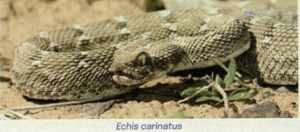
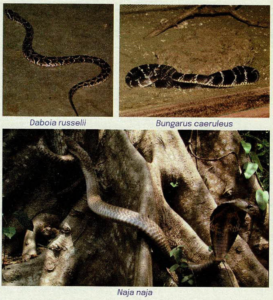
- Snakebites pose a significant health risk globally, with South Asia, particularly India, bearing a disproportionate burden.
- India records a staggering number of snakebite cases annually, earning the dubious title of the world’s snakebite capital.
- The four giant venomous snakes, including saw-scaled viper (Echis carinatus), common krait (Bungarus caeruleus), Russell’s viper (Daboia russelii), and spectacled cobra (Naja naja), are responsible for most fatalities.
Challenges in Managing Snakebite Cases
- Despite the high incidence of snakebites, accurate reporting and management remain challenging.
- Official records often underestimate the actual mortality figures, and rural areas face significant hurdles in accessing timely and adequate treatment.
- Shortages of antivenom, lack of trained medical personnel, and delays in reaching healthcare facilities contribute to the high mortality rate.
Treatment and Antivenom Shortages
- The gold-standard snakebite treatment involves administering antivenoms derived from venomous snake species’ antibodies.
- However, challenges arise due to regional variations in venom composition and the limited availability of effective antivenoms.
- Recombinant antivenoms offer a potential solution but require further research and development.
Role of NGOs and Private Initiatives
- Amidst these challenges, NGOs and private groups play a crucial role in raising awareness, providing support, and advocating for better snakebite management.
- Initiatives like the Snakebite Interest Group and the Snakebite Healing and Education Society work tirelessly to educate communities, train healthcare workers, and ensure timely access to treatment.
Addressing the Neglected Healthcare Issue
- Despite efforts by NGOs and private groups, snakebite remains a neglected healthcare issue in India.
- Urgent attention is needed to improve awareness, enhance healthcare infrastructure, and address the systemic challenges contributing to the high mortality rate.
- Collaboration between government agencies, healthcare professionals, and civil society is essential to tackle this public health crisis effectively.
ARTICLE 11: SNAKE EATING BIRDS
Birds: Essential Contributors to Ecosystems
- Birds play a crucial role in ecosystems, providing ecological benefits such as seed dispersal, pollination, and pest control.
- Among them are some unusual species that aid in ecological balance by preying on reptiles, particularly snakes.
- Despite the rarity of such behaviour, these birds help maintain predator-prey balance remarkably well.
Ophiophagy: The Phenomenon of Snake Eating
- In the natural world, animals exhibit diverse feeding habits, with some specialising in consuming specific food types.
- Birds, too, display a range of dietary preferences, including a group known for their penchant for hunting and eating snakes, a behaviour termed ophiophagy.
- Equipped with sharp beaks, keen eyesight, and hunting instincts, these birds effectively catch and kill snakes in the wild.
Serpent Killers: True Hunters and Opportunists
- Birds that prey on snakes can be divided into two main categories: true hunters and opportunistic feeders.
- True snake hunters, such as raptors and roadrunners, possess specialised features adapted for killing dangerous snakes.
- On the other hand, opportunistic feeders, like peacocks and herons, may consume snakes when food resources are scarce or to defend against snake threats.
Notable Snake-Eating Birds
- Several bird species are renowned for their ability to hunt and consume snakes.
- Roadrunners in the southwestern United States are known for preying on rattlesnakes.


- Secretary birds, native to Africa, use their powerful legs to kick and kill venomous snakes.


- Serpent eagles, primarily found in Asia, feed on large poisonous snakes.


- Even storks, with their long bills and stout legs, include snakes in their diet, demonstrating the diversity of bird species that engage in ophiophagy.
- Indian Peacocks (Pavo cristatus) are omnivorous ground-feeders known for their vibrant feathers and impressive courtship displays. They consume insects, plants, and small creatures and hold the distinction of being the national bird of India.
- Contrary to common belief, there are birds that prey on snakes, showcasing the diversity of nature. These include water birds, birds of prey, and domestic birds, among others. However, many bird species face threats such as poaching, habitat destruction, and hunting, leading to their endangerment. Given their importance to ecosystems and our own survival, these birds require our support for their conservation and continued existence.

Challenges and Conservation
- Despite their remarkable behaviors, many bird species face threats such as poaching, habitat destruction, and hunting, pushing them towards extinction.
- Conservation efforts are crucial to ensure these birds’ survival, which are fascinating to observe and essential for maintaining ecological balance.
- With concerted efforts, we can protect these avian treasures and preserve the biodiversity they contribute to our ecosystems.
ARTICLE 12: Life without the Queen Bee: Inside a Beehive Ordeal
The Honeybee Colony: A Complex Social Structure
- Honeybee colonies, with their intricate social dynamics, consist of three distinct castes: worker bees, queen bees, and drones, each contributing uniquely to the hive’s functions.
- The queen, dedicated solely to egg-laying, is central to the colony’s productivity, dictating harmony within the hive.
- Worker bees, the smallest members, perform essential tasks, while drones play a role in mating to propagate the colony.
The Queen’s Influence and Absence

- Queen bee pheromones maintain social cohesion and communication within the hive, ensuring order among the workers and drones.
- However, the hive’s harmony is disrupted in the queen’s absence, prompting worker bees to rear a new queen.
- If this process fails or is prolonged, worker bees may begin laying eggs themselves, leading to a skewed gender ratio and compromised egg-laying capabilities.
Consequences of Queenlessness
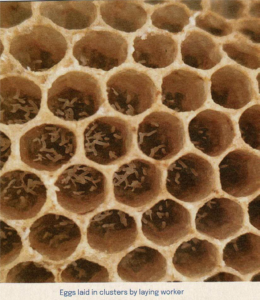
- In a queenless colony, the population dwindles as worker bees age, compromising essential tasks such as foraging and nursing larvae.
- Honeybees may accept laying worker bees as queens, rejecting any new queens introduced.
- Timely intervention by beekeepers, such as introducing a new queen, is crucial to restore balance and prevent colony loss and decreased honey production.
Detecting Queenlessness and Remedial Measures
- Experienced beekeepers can detect queenlessness by observing bee behaviour and hive conditions.
- Distinct behaviours, such as a peculiar cry from the hive, signal distress, indicating queenlessness.
- Based on these observations, beekeepers may introduce a new queen to restore colony stability and productivity.
The Significance of the Queen Bee
- Nature’s design favours a solitary queen for hive stability and genetic integrity, ensuring optimal traits and colony health.
- The queen ensures the continuity of generations, genetic diversity, and societal order within the hive, highlighting her indispensable role in honeybee colonies.


